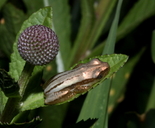|
Afrixalus stuhlmanni (Pfeffer, 1893)
| family: Hyperoliidae genus: Afrixalus |
 © 2015 Martin Pickersgill (1 of 21) |
|
|
|
Description The subspecies A. s. brachycnemis has a more variable pattern (Pickersgill 2007 recognized two subspecies: A. s. stuhlmanni and A. s. brachycnemis but see the latter's species account. Distribution and Habitat Country distribution from AmphibiaWeb's database: Kenya, Malawi, Mozambique, Tanzania, United Republic of, Zambia
Life History, Abundance, Activity, and Special Behaviors Possible reasons for amphibian decline Urbanization Comments
References
IUCN, Conservation International, and NatureServe. 2006. Global Amphibian Assessment: Afrixalus stuhlmanni. www.globalamphibians.org. Accessed on 23 August 2008. Pickersgill, M. (2005). ''The taxonomy and ethology of the Afrixalus stuhlmanni complex (Anura: Hyperoliidae).'' Steenstrupia, 29(1), 1-38. Pickersgill, M. (2007). Frog Search: Results of Expeditions to Southern and Eastern Africa. Edition Chimaira, Frankfurt am Main. Poynton, J. (2006). ''On dwarf spiny reedfrogs in Tanzanian eastern lowlands (Anura : Afrixalus) : short communication.'' African Journal of Herpetology, 55(2), 167-169. Poynton, J. C. and Broadley, D. G. (1987). ''Amphibia Zambesiaca 3. Rhacophoridae and Hyperoliidae.'' Annals of the Natal Museum, 28, 161-229. Schiøtz, A. (1974). ''Revision of the genus Afrixalus (Anura) in Eastern Africa.'' Vedenskabelige Meddelelser fra Dansk Naturhistorisk Forening, 137, 9-18. Originally submitted by: Arne Schiøtz (first posted 2008-08-23) Edited by: Kellie Whittaker, Michelle S. Koo (2023-11-10) Species Account Citation: AmphibiaWeb 2023 Afrixalus stuhlmanni <https://amphibiaweb.org/species/466> University of California, Berkeley, CA, USA. Accessed Nov 12, 2024.
Feedback or comments about this page.
Citation: AmphibiaWeb. 2024. <https://amphibiaweb.org> University of California, Berkeley, CA, USA. Accessed 12 Nov 2024. AmphibiaWeb's policy on data use. |


 Map of Life
Map of Life